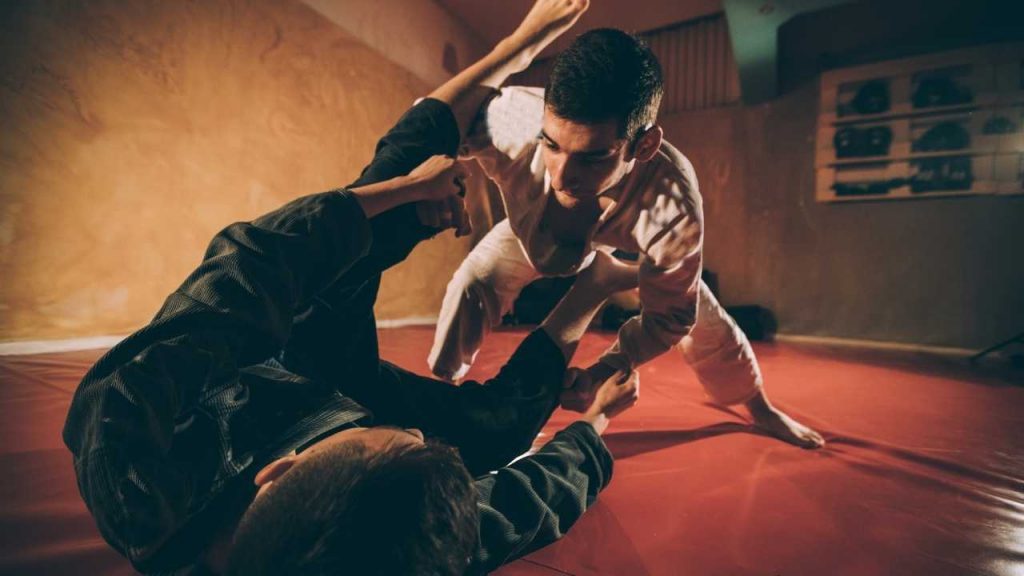For the uninitiated, MMA may be seen as a lawless sport where anything goes but that’s simply not true. There are many moves that are illegal in the sport and one of those is the 12-6 elbow. But why is it illegal and what is the penalty for using it?
That’s exactly what we’re going to find out here, so read on to find out more!
Table of Contents
What is a 12-6 Elbow?
Understanding the term “12-6 elbow” is simple once you know that the numbers represent the faces of a clock.
To execute a 12-6 elbow, the fighter raises their arm as high as possible (in the 12 o’clock position) and then drives it downward with maximum force (6 o’clock position) to try and knock out their opponent.
Simply put, a 12-6 elbow is where you lift your elbow as high as possible and drive it straight down. There are many things that the strike could have been called but they went with the numbers on a clock.
The use of the elbow can be highly effective and other types of elbow have knocked out many opponents in the UFC with MMA elbow strikes, but the 12-6 elbow is not allowed.
Why are 12-6 Elbows Illegal?
This is a contentious issue and one that goes back to the unified rules of MMA. In the early 2000s, it was agreed that a universal set of rules were required to give MMA more credibility and make it easier for state commissions to accept the sport.
The rules were drawn up with the New Jersey athletic commission and it’s said that their commissioner wanted all elbow strikes banned. Legendary referee John McCarthy was at the meeting and argued for the use of elbow strikes.
Due to this, a compromise was made. The story goes that the commissioner had seen the 12-6 elbow used in a brick-breaking competition and deemed it too dangerous. The MMA side of the meeting settled with banning the 12-6 elbow but keeping all other elbow strikes legal.
For many people, it was a compromise that never held much weight. While a 12-6 elbow can deal a lot of damage to an opponent, it’s no more dangerous than many other strikes that are allowed in the UFC.
If a poll was taken, the majority of people would almost certainly prefer taking a 12-6 elbow when they are on the ground compared to a spinning elbow to the chin. Yet, the latter is allowed, as are other more dangerous moves, such as spinning kicks.
You could also debate that an 11-7 elbow, or even a 9-3 elbow is equally as damaging as a 12-6 elbow, yet they are allowed. In that context, banning the 12-6 elbow doesn’t make a lot of sense but it was important to create the unified rules, hence the compromise.
Rules of the 12-6 Elbow in UFC
The exact working in the Unified Rules of Mixed Martial Arts is:
“Downward pointing elbow strike (12 to 6): The use of a linear “straight up straight down” elbow strike is prohibited. Any variation of this straight-up-and-down linear elbow strike makes the strike legal. Any arc, or any angle change from straight up to straight down makes the strike legal. Any variation of position does not alter the legality of the strike.”
As you can see the rules clearly allow any other form of elbow strike, than those slightly out of the 12-6 position. The only time in the rules where elbows are mentioned as an illegal move is when used for eye gouging.
Penalties for 12-6 Elbow Strikes in the UFC
There isn’t one set penalty for using the 12-6 elbow strike. The exact consequence of using one will often depend on the situation of the fight and the damage caused by the elbow.
On most occasions, the fight will be stopped and the offending fighter will be warned. Any other instances of the elbow being used will likely result in at least a points deduction and the judges will be informed of the penalty.
If the foul is severe, such as knocking out of incapacitating the opponent, then the use of the 12-6 elbow will result in disqualification. In this scenario, the offending fighter will have been deemed to have lost the fight and his opponent won.
Notable UFC Fights Featuring 12-6 Elbow Strikes
While there have been instances of the 12-6 elbow being used in fights before, there is only one famous incident and it happened in The Ultimate Fighter 10 Finale back in December 2009 when Jon Jones fought Matt Hamill.
Going into the fight, Jones had a perfect 9-0 record and Hamill was seen as one of the best fighters in the sport. Jones dominated the contest and delivered a series of side elbows to the hapless Hamill and the fight looked all but over.
But after that, Jones switched his elbow position and delivered two downward pointing elbow strikes. The referee instantly stopped the contest to deduct a point from Jones but Hamill stayed on the canvas and couldn’t continue.
At this point, everyone thought Jones had won the fight but the disqualification was soon revealed. It is still the only loss in Jones’ career and many see him as the greatest UFC fighter of all time. There have been attempts since to make the 12-6 legal but to no avail.
12 to 6 Elbow – FAQs
When did 12-6 elbows become illegal?
The UFC rules elbows illegal in the 12-6 position but when did this happen? The ban on 12-6 elbows came in with the Unified Rules of Mixed Martial Arts which can into effect in 2001. Since then all MMA organizations, including the UFC, adopted the rules which made it much easier to get approval for their events.
Can you use elbows in UFC?
Yes, all elbows in MMA are legal with the exception of the 12-6 strike. There have been many devasting finishes using the use of elbows which makes the continued illegality of the 12-6 elbow even stranger.
How did Jon Jones lose a fight?
Jon Jones’ one and only loss came via disqualification from using the 12-6 elbow to finish the fight vs Matt Hamill. The disqualification was technically correct from the referee but it remains hugely controversial as Jones has looked seconds away from winning the fight anyway.


